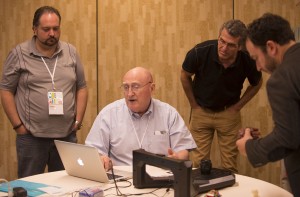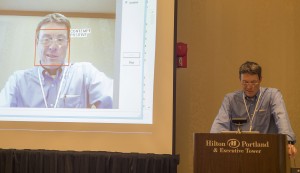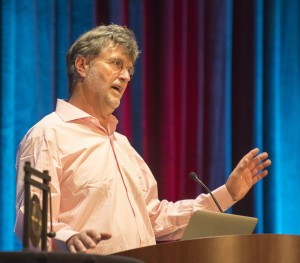 The New Media Consortium annual conference is a great opportunity to discuss trends within Higher Education and educational institutions from around the world. This year’s conference in Portland brought together innovators and trail blazers delivering education through technology from around the world.
The New Media Consortium annual conference is a great opportunity to discuss trends within Higher Education and educational institutions from around the world. This year’s conference in Portland brought together innovators and trail blazers delivering education through technology from around the world.
Even before the conference began pre-conference sessions were held, including a session on 3D printing and scanning which I attended as ODEE looks at options for bringing 3D printing to students on campus. New application ideas for 3D that were striking included a program called Photo To Mesh which converts light areas of a photo to raised surfaces and dark areas to lower areas, the application might be a representation of a cell mitosis that a vision impared student would be able to feel rather than see.
The opening keynote address was by Jason Ohler, an educator and author who developed early  educational technology training programs for teachers. Ohler’s talk highlighted several accelerating trends that will effect higher education including Big Data, and Immersion or Augmented Reality.
educational technology training programs for teachers. Ohler’s talk highlighted several accelerating trends that will effect higher education including Big Data, and Immersion or Augmented Reality.
Technology companies of all sizes are storing increasing amounts of data tracking everything from location and network settings to engine monitoring in large machinery. Ohler pointed to a recent case where an airliner developed engine trouble in flight, so the plane manufacturer and the airline reviewed gigs of engine data in a web conference from around the country, identified the problem, and created a list of likely solutions, all before the plane landed at the destination airport. Impossible a decade or two ago, this instant access to data and ability to collaborate across the world empowers people in new way that we’re just beginning to grasp.
Consumer data is also being collected and stored at exponentially growing rates. In many cases, when customers log into a store’s “free” internet connection they are tracked as they shop, and that data is likely cross referenced to the actual purchases when they swipe a shopper card and check out. The collection and analysis of these sorts of data are beginning to occur within higher education. Analytics around student grades and engagement around course discussion boards and homework assignments are going to be gathered and analyzed more and more in the future. As technology evolves students must know this data is being collected and analysts must utilize this data in ways to help students achieve their greatest potential and improve the university; both goals are tenants of good digital citizenship.
 Unlike Virtual Realty, which cuts a viewer off from their surroundings, Immersion is a blended environment like one created when wearing Google Glass. The street you walk upon can be tagged with information about events, movie times, or whatever information might be pushed to a passer-by. The advent of smaller processors, GPS, and wireless/cellular communication gear ensures we’ll see more devices soon. Google Glass, FitBit, and the rest are strictly version 1.0 in an area of vast potential. Ohler sees great potential in this space for systems that improve learning outcomes for students in fun and engaging ways.
Unlike Virtual Realty, which cuts a viewer off from their surroundings, Immersion is a blended environment like one created when wearing Google Glass. The street you walk upon can be tagged with information about events, movie times, or whatever information might be pushed to a passer-by. The advent of smaller processors, GPS, and wireless/cellular communication gear ensures we’ll see more devices soon. Google Glass, FitBit, and the rest are strictly version 1.0 in an area of vast potential. Ohler sees great potential in this space for systems that improve learning outcomes for students in fun and engaging ways.
Another session of interest was conducted by Intel’s Eric Cooper, showcasing some of the facial and gesture recognition technology beginning to emerge in the computing industry. Cooper suggested future laptops will have dual video cameras built into the machine, which will allow programers to develop gesture based commands for this next generation of equipment, much in the way a Microsoft Kinect uses two cameras and user motion to control games written to utilize this system. Facial recognition using measurement of distances between the features on a person’s face is an established technology, however now work is being done to translate facial expressions into a ‘mood’ interpreter which might be used in future consumer or security products.
 Not everything revolved directly around technology during the conference. Digital Storytelling has always been an area of interest within the NMC, and this year a master, Sports Illustrated photographer Bill Frakes led a session showcasing some of his recent work in his childhood home of Nebraska, where cranes pause on their migration route each spring. The photography and video work was simply beautiful. View the story Cranes here. Frakes also shared a piece he had recently created about his mother’s work teaching in a one room school house; an interview with one of the students she impacted through her work was a moving part of this digital story.
Not everything revolved directly around technology during the conference. Digital Storytelling has always been an area of interest within the NMC, and this year a master, Sports Illustrated photographer Bill Frakes led a session showcasing some of his recent work in his childhood home of Nebraska, where cranes pause on their migration route each spring. The photography and video work was simply beautiful. View the story Cranes here. Frakes also shared a piece he had recently created about his mother’s work teaching in a one room school house; an interview with one of the students she impacted through her work was a moving part of this digital story.
The 2014 NMC conference offered sessions on myriad changes and trends coming to higher education, however the message imparted by Nik Honeysett of the Balboa Park Online Collaborative might have been the most important. Honeysett suggested the 5 year planning and implementation cycles of old no longer allow institutions to remain competitive when new breakthrough technology like the iPhone, iPad, and Glass are appearing on a three year cycle. Rather than following the old model, an ongoing cycle of technology review and realignment is necessary to keep an institution on track toward its goals in a constantly changing technology landscape. As we look at the tremendous changes we have experienced and continue to experience as technology evolves and improves, agility and flexibility remain our best guard against long term decisions that lock our institution into a model from the past.
